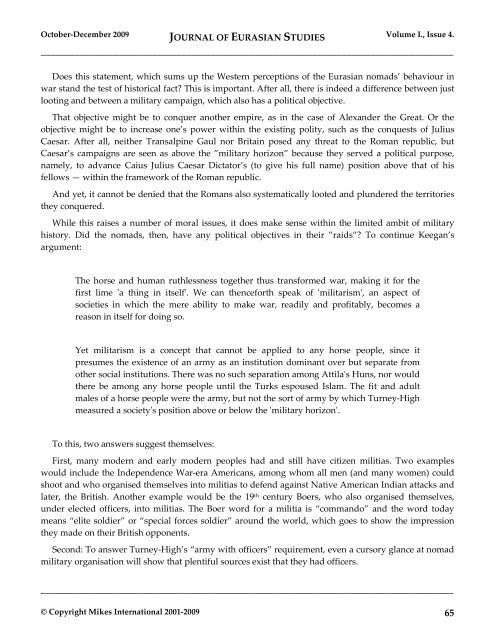JOURNAL OF EURASIAN STUDIES
JOURNAL OF EURASIAN STUDIES
JOURNAL OF EURASIAN STUDIES
Create successful ePaper yourself
Turn your PDF publications into a flip-book with our unique Google optimized e-Paper software.
October-December 2009 <strong>JOURNAL</strong> <strong>OF</strong> <strong>EURASIAN</strong> <strong>STUDIES</strong> Volume I., Issue 4.<br />
_____________________________________________________________________________________<br />
Does this statement, which sums up the Western perceptions of the Eurasian nomads’ behaviour in<br />
war stand the test of historical fact? This is important. After all, there is indeed a difference between just<br />
looting and between a military campaign, which also has a political objective.<br />
That objective might be to conquer another empire, as in the case of Alexander the Great. Or the<br />
objective might be to increase one’s power within the existing polity, such as the conquests of Julius<br />
Caesar. After all, neither Transalpine Gaul nor Britain posed any threat to the Roman republic, but<br />
Caesar’s campaigns are seen as above the ”military horizon” because they served a political purpose,<br />
namely, to advance Caius Julius Caesar Dictator’s (to give his full name) position above that of his<br />
fellows — within the framework of the Roman republic.<br />
And yet, it cannot be denied that the Romans also systematically looted and plundered the territories<br />
they conquered.<br />
While this raises a number of moral issues, it does make sense within the limited ambit of military<br />
history. Did the nomads, then, have any political objectives in their ”raids”? To continue Keegan’s<br />
argument:<br />
The horse and human ruthlessness together thus transformed war, making it for the<br />
first lime 'a thing in itself'. We can thenceforth speak of 'militarism', an aspect of<br />
societies in which the mere ability to make war, readily and profitably, becomes a<br />
reason in itself for doing so.<br />
Yet militarism is a concept that cannot be applied to any horse people, since it<br />
presumes the existence of an army as an institution dominant over but separate from<br />
other social institutions. There was no such separation among Attila's Huns, nor would<br />
there be among any horse people until the Turks espoused Islam. The fit and adult<br />
males of a horse people were the army, but not the sort of army by which Turney-High<br />
measured a society's position above or below the 'military horizon'.<br />
To this, two answers suggest themselves:<br />
First, many modern and early modern peoples had and still have citizen militias. Two examples<br />
would include the Independence War-era Americans, among whom all men (and many women) could<br />
shoot and who organised themselves into militias to defend against Native American Indian attacks and<br />
later, the British. Another example would be the 19 th century Boers, who also organised themselves,<br />
under elected officers, into militias. The Boer word for a militia is “commando” and the word today<br />
means “elite soldier” or “special forces soldier” around the world, which goes to show the impression<br />
they made on their British opponents.<br />
Second: To answer Turney-High’s “army with officers” requirement, even a cursory glance at nomad<br />
military organisation will show that plentiful sources exist that they had officers.<br />
_____________________________________________________________________________________<br />
© Copyright Mikes International 2001-2009 65
















